Macrophotography is one of the main attraction of the OM system. In fact, Olympus has been a undisputed market leader in this segment for quite a long spell of time and most often if your primary interest is in close-up or macro works, OM system offers the best solution as a total system to fulfill such requirement. The vast array of precision equipment in the Macrophoto Group gives the creative and scientific photographer alike a perfect grasp of subjects too small to be handled by the standard lenses, and allows maximum magnifications of more than ten times life size. Including everything from close-up lenses and extension tubes to auto bellows, a series of seven macro lenses, macro flash, stands, illuminators., etc., the group comprises the most comprehensive and versatile macrophoto system available anywhere. In fact, even during the early days of the OM system, there were already an array of four macro lenses, among which are the unique 1:1 reproduction ratio 80mm f/4.0 and the 50mm f/3.5 which can equally well be used as a standard lense in the system. Even for In indoor photography every kind of work including reproduction of documents and photographs can be carried out with total control over type of illumination as well as light quality. But no doubt, the most significant breakthrough was the revolutionary TTL Direct OTF Light Measuring flash metering first debuted with the Olympus OM-2(n) which has truly opens enormous amount of photographic possibilities in application of macrophotography. The system which obviates the need for highly critical exposure calculations, and permits completely automatic close distance flash photography. The magnificently comprehensive and simplicity of operation of system accessories have formed the basis which leads to making Olympus the world leader in this field with a diversity of system accessories and range of performance no other 35mm SLR system can match. As this section only focuses on lenses and we will leave other system components aside (you may refer them at the respective OM cameras sections where it outlines their respective functions and usage).
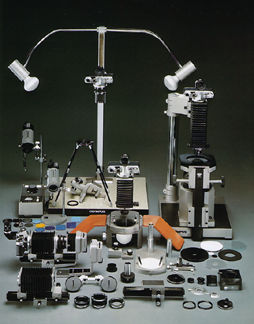 |
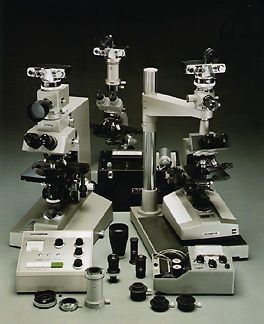 |
The OM system Macro Photo group provides optimum resolution through a range from infinity to over 12 times life size with quite a wide array of system accessories for such intended use. You can start right from buying a simple close up filter mount on your lense to increase the magnification ratio of the primary picture taking lense, naturally, it has limitations in performance. |
Conventional macro lenses (even many ZUIKO Zoom lenses introduced at later stage has a macrofocus feature) are designed to deliver their best performance at magnification up to 1/10 life size and can be used with good results for general close-up photography, As magnification increases to life size or beyond, the lense performance drops sharply. To overcome this problem, Olympus optical engineers created three special macro lenses designed to meet the resolution demands of high magnification photography. The early OM Macrophoto group has a few options of such specialized macro lenses. One of the major problems of macrophotography is that lense quality suffers at magnification of 1:1 or greater. However, an additional consideration is the fact that many times higher magnifications cannot be attained because the lense extension possible is limited by the length of the bellows itself, The three ZUIKO Macro lenses, however, were designed exclusively for macrophotography, recopying and close-up work in conjunction with the Auto Bellows. (A mounting attachment is necessary for the Macro 20rnrn and 38mm). By offering a choice of few focal lengths, the ZUlKO Macro Lens Group enables the photographer to achieve the highest possible resolution throughout the magnification range of each individual lense. The magnification range for each of these early versions of the Zuiko Macro lenses is as follows:
MACRO 20mm f/3.5 - 4X to 12X
MACRO 38mm f/3.5 - 1.8X to 6X
MACRO 1:1 80mm f/4.0 - 1/2X to 2X
Credit: Mr. S. Martin who has contributed his time to prepare the scanning process of the Instruction Manual of the Auto Tube 65-116mm.
The next major Zuiko lens updating program occurred during the first quarter of the '80 saw many subsequent improved and/or new versions/models being introduced. Check at individual sections that follows.
|
 |
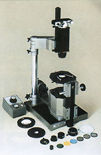 |
<<<--- The images shown in a 10/1992 publication of OM system brochure illustrate two main change in system applications, indoor and extensive availability of flash system for both macro/Photomicro group; besides, the system is "cleaner" in numbers as compared to older days. |
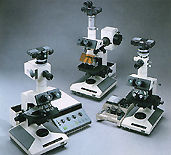 |
Well, the only complaint I have for the OM system as a whole is, the ZUIKO lacks a long reaching, versatile helical focusing macro-tele lense in the system. Although in a way you can use a accessory such as Telescopic Auto Tube and Close-up lense to increase the working range but still, it is not as versatile as a true tele-macro lense in particular when you are shooting on locations. Further, the followed up system has streamlined (a better word for phasing out) many of the older system accessories which has BOTH the macrophoto and Photomicro group less comprehensive in numbers and varieties. However, one main issue contributed to such change of direction is automation which has made both system much easier and precise to operate and has it well compensated. Anyway, except for the little self set desire, what the OM system has to offer still shines in its overall performance and there is no doubt why there are so many great photographers who never stops to excite me with stream of wonderful macro images that keep surfacing all these years.
As the entire Zuiko lense group can separate into two main criteria, one which does not have a Helicoid mechanism in the lense which needs to be used with a medium to focus while another group of Zuiko macro lenses have helical focusing on it own and can be use as a normal lense. As for the first group, common system accessories that enables focusing are Auto Bellow Units, Auto Extension Tube and/or PM-MTob, while the latter are more flexible and versatile as it can be a standalone optical lense and/or using any of the mentioned accessories to achieve higher magnifications. Some older non-helical focusing Zuiko macro lenses may not have auto diaphragm and stopped down metering is required for exposure measurement while most newer versions may have incorporated an automatic diaphragm inside the design. Further, although many of the older system accessories may not be available now but some of these useful gadgets are still surfaced regularly at public auction houses where you can take your time patiently look for bargain.
 |
<<<--- An overview of combinations of various OM Macro lenses/accessories for respective reproduction ratio. PLEASE study table here first to get a rough idea before proceeding to other pages. |
 |
<<<--- The Zuiko MACRO lense series appeared in a 1983 OM sales catalogue. Please note Olympus has not mentioned early version of the 20mm and 38mm are multicoated. |
Zuiko MC MACRO 20mm f/3.5 (discontinued)
This tiny, simple but manually operated Zuiko Macro lense was designed exclusively for macrophotography in conjunction with the Auto Bellows (an optional coupling attachment such as an objective lens Mount PM-MTob is necessary). As early version that published has not been mentioning whether the lense was multicoated but those marketed at later stage (probably after 1978) was believed to have been multicoated to minimize flare and ghost images. The later version was generally indicated as MC lense and usable with other accessories such as Bellows/auto tubes/PM-Mtob combinations.
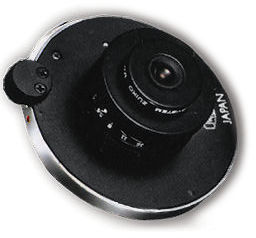 |
The assignment for this lense is to exert high resolution and contrast at magnifications from 4X (5mm x 8mm) to 12X (2mm x 3mm). In macrophotography at such high magnifications, illumination, camera stability and subject's position become hard to fine adjust. The use of a macrophoto stand and accessory illumination devices (such as flash) is recommended. With OM-2 TTL flash with early AUTO thirstier 310 was used but latter Olympus T30 or equivalent can be of good substitutes. The PMT-35, a highly sophisticated macrophoto apparatus, Is available for advanced amateurs and skilled experts. This Zuiko Macro lense was substituted by a faster version Zuiko MC Macro 20mm f/2.0 lense sometime in 1984. |
Specifications:
Focal length: 20mm
Angle of view: 9° (at its highest magnification)
Optical construction: 4 elements in 3 groups; Multicoated for later versions
unknown for earlier ones.
Diaphragm operation: Manual
Aperture range: f/3.5-f/16
Minimum focus: 0.13m (5.1")
 |
Minimum photographic range: 5mm x 8mm ~ 2mm x 3mm |
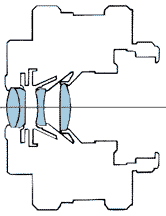 |
Recommended Focusing Screens: 1-1*, 1-2*, 1-3*, 1-4*, 1-10*, 1-12#, 1-13* and 1-14*. * Compatible. # The 1-12 (cross hairs-clear field type) offers a brighter image, but the meter built into the OM-1 and OM-2 ton MANUAL) does not give correct light readings, With the OM-2 on AUTO, correct exposures are made on the film but the meter needle does not give correct light readings. |
| Previous | NEXT | 1/5 The fast speed f/2.0 version of the Zuiko 20mm MACRO and both the Zuiko MACRO 38mm f/3.5 and f/2.8 versions.
Zuiko Macro/Close focus lenses: Zuiko AUTO MACRO 20mm f/3.5 | Zuiko AUTO MACRO 20mm f/2.0 | Zuiko AUTO MACRO 38mm f/3.5 | Zuiko AUTO MACRO 38mm f/2.8 | Zuiko AUTO MACRO 50mm f/3.5 | Zuiko AUTO MACRO 50mm f/2.0 | Zuiko AUTO MACRO 1:1 80mm f/4.0 | Zuiko AUTO MACRO 90mm f/2.0 | Zuiko AUTO MACRO 135mm f/4.5
Zuiko Fisheye
Lenses 8mm
f/2.8
Circular Fisheye | 16mm f/3.5 Full Frame Fisheye
Zuiko Ultra-Wideangle Lenses 18mm f/3.5 | 21mm f/2.0 | 21mm f/3.5 | 24mm f/2.0 | 24mm f/2.8
Zuiko Wideangle Lenses 28mm f/2.0 | 28mm f/2.8 | 28mm f/3.5 | 35mm f/2 | 35mm f/2.8 |
Zuiko Standard Lenses 40mm f/2.0 | 55mm f/1.2 | 50mm f/1.2 | 50mm f/1.4 | 50mm f/1.8 | Zuiko 50mm f/2.0 PF
Zuiko Medium-Telephoto Lenses 85mm f/2.0 | 100mm f/2.0 | 100mm f/2.8 | 135mm f/2.8 | 135mm f/3.5
Zuiko Telephoto Lenses 180mm f/2.0 EDIF | 180mm f/2.8 | 200mm f/4.0 | 200mm f/5.0 Auto-T (brief)
Zuiko Super-Telephoto Lenses 250mm f/2.0 EDIF | 300mm f/4.5 | 350mm f/2.8 EDIF | 400mm f/6.3 | 500mm | 600mm f/6.5 |1000mm f/11.0
Special application Zuiko optics: 24mm f/3.5 Shift | 35mm f/2.8 Shift | 500mm f/8 Reflex | AF Zoom 35-70mm
f/4.0
| Zuiko
50mm f/2.0 PF
Tele-Converters: 1.4X-A / 2X-A
Zuiko AUTO-Zoom
Lenses - Main
Index page
| S-Zuiko
AUTO Zoom 28-48mm f/4.0
|
Zuiko AUTO Zoom 35-70mm f/3.6
|
S-Zuiko AUTO Zoom 35-70mm f/4.0
|
Zuiko AF AUTO Zoom 35-70mm f/4.0
| S-Zuiko
AUTO Zoom 35-70mm f/3.5 ~ f/4.5
| S-Zuiko
AUTO Zoom 35-70mm f/3.5 ~ f/4.8
| Zuiko
AUTO Zoom 35-80mm f/2.8 ED
|
Zuiko AUTO Zoom 35-105mm f/3.5 ~ f/4.5
| Zuiko
AUTO zoom 50-250mm f/5.0
|
Zuiko AUTO zoom 65-200mm f/4.0
|
S-Zuiko AUTO zoom 70-210mm f/4.5 ~ f/5.6 | Zuiko AUTO Zoom 75-150mm f/4.0 | Zuiko AUTO Zoom
85-200mm
f/4.0
| Zuiko
AUTO Zoom 85-250mm f/5.0
| S-Zuiko
AUTO Zoom 100-200mm f/5.0
|
| Back | Index Page of OM Zuiko lenses
| Back | to Main Index Page of OM1(n) & OM2(n)
Series SLRs
| Message Board | for
your favourite Olympus
OM-1(n)
and OM-2(n)
series models
| Message
Board | for your Zuiko
Optics in a shared environment
| Message Board | Specifically for Dispose or Looking for OM Photographic
Equipment
About this photographic site.
Home - Photography in Malaysia |
Copyright
© 2000.
leofoo ®. MIR Web Development Team.
Maintainers
for OM Zuiko Site & Message Board:
Rick
Oleson (Email: rick_oleson@yahoo.com Website:
http://rick_oleson.tripod.com), Bruce Hamm
(bhamm@magma.ca), John Orrell
(john@orrellj.freeserve.co.uk), Simon Evans,
(http://www.mawddwy.freeserve.co.uk); Shaun
(shaun@noemail.com), Andy Radcliffe
(AndyJRadcliffe@manx.net)
Special
thanks to:
Gregory
P. Logiodice, Bob Gries, Erwin Voogt, Joel Wilcox, Rick
Oleson, Simon Evan and many others for granting permissions to use their images
of either lenses, cameras and own pictures appeared in this Zuiko website.
Credit: My old time buddy,
Ahmad
Ikram,
Dr of Rubber Research Institute (RRI), Malaysia
who shares the same passion with me and also lending his OM-1n, OM-4 and the Motor
Drive 1 to me for preparing some images in this site; Mark Dapoz <md@dementia.org>for reminding
some broken links; Mr Poon of Foto Poon, Ipoh, Mr Richard, Ampang Park,
Mr Lim and Miss Jenny of Foto Edar for their generosity for
their OM1(n), OM2n camera and some Zuiko lenses. Mr Hans van Veluwen for
mistakenly using some content earlier from his OM website; J Sorensen
for providing some useful images to rectify some technical "flaws"; Mr
Gen Holst for helping during the early stages of development of this OM site;
Mr KKLow for some of his earlier images on the OM-1appeared in this website;
Miss Wati and Mirza for helping me
to convert this Operation Manual into a HTML format. Mr MCLau for rectifying
some mistakes made on the earlier preview sites. A personal tribute to the creator
of the OM system and also a site dedicated to all the fans of Olympuses and Zuiko
Optics worldwide. Some of the content and images appeared in this site were scanned
from OM official marketing leaflets, brochures and instruction manual(s) for educational
purposes. Olympus is a registered trade name of Olympus Optical Inc., Japan. Site
created 'unfortunately again with an IMac.
